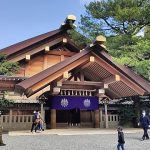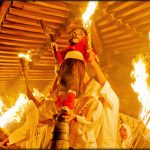The annual Fire Walking Shrine (Fire Festival), held on December 12, is a solemn occasion where numerous ascetics and devotees tread barefoot across the temple’s sacred grounds. This ritualistic walk expresses their prayers for protection against fires, the alleviation of hardships, and extending life. The fun part of this festival is that you can walk through the fires too, proving your willingness to walk through fire, I guess.
The Historical Roots of Akibasan Temple
The foundation of Akibasan Temple is steeped in legend and spirituality. It was established by Kūkai, also known as Kōbō-Daishi, a revered Buddhist teacher who introduced the esoteric and tantric form of Buddhism known as Mikkyō. This temple enshrines the fire kami (god), Sanjakubo Daigongen, a symbol of protection against fire.
Sanjakubo’s journey from a wandering priest in Shinano (now Nagano prefecture) to becoming a revered deity is a tale of mystical transformation. His encounter with Acala (Fudō-myōō in Japanese), a deity depicted as a wrathful sword-wielding figure engulfed in flames, led Sanjakubo to his destiny as Akiba kami, the guardian against fire.
During the mid-Edo period, Akiba kami’s worship flourished, intertwining Shintoism and Buddhism. This coexistence was challenged during the Meiji era when the government enforced a separation of these practices. Yet, the temple at Entsu-ji, a sanctuary for Akiba kami, survived these changes, preserving its ancient rituals and traditions.
The Ritual of Hiwatari Shinji
The Hiwatari Shinji is a ritual of endurance, faith, and purification. It begins with the Shichijuugozen-jinku, where mochi rice cakes are offered to 75 mountain gods, a nod to the temple’s Buddhist roots. The ritual then transitions to the participation of shugenja, ascetic mountaineering priests known for their strict discipline and spiritual pursuits. Clad in white kimonos, these priests lead prayers for prosperity, recite sutras, and engage with followers in spiritual dialogues.
The heart of the ceremony is the Homa (Goma) ritual, a sacred fire ceremony unique to Vajrayana and Esoteric Buddhism. This daily ritual is believed to purify both the spirit and the mind. But during the Hiwatari Shinji, it escalates into a mesmerizing fire walk. The shugenja chant kuji-in, nine-syllable mantras, as they bravely stride across burning coals. This act is not just a test of physical endurance; it’s a profound prayer for protection from natural calamities, theft, accidents, poverty, and premature death.
An Open Invitation
Remarkably, the ritual is not exclusive to the priests. After the shugenja have completed their walk, followers and even spectators are invited to participate. This openness symbolizes the inclusive nature of the ritual, inviting all to partake in this spiritual cleansing.
Visiting Akibasan Entsu-ji
For those looking to experience this unique festival, the Akibasan Entsu-ji shrine near Atsuta Jinga is the destination. The rituals commence early in the morning, with the fire walking between 7 pm and 9 pm. Access is convenient via the Meijo subway Line to Tenma-cho or the Meitetsu line at Jingu-mae.
The Hiwatari Shinji at Akibasan Entsu-ji is more than a ritual; it’s a living bridge to Japan’s past, a celebration of endurance, and a testament to the country’s rich spiritual tapestry. Whether you’re a participant or a spectator, this event offers a unique glimpse into a tradition that beautifully combines faith, history, and the enduring human spirit.
Akibasan Entsu-ji
Annualy on December 12
2 Chome-3-15 Jingu, Atsuta Ward, Nagoya, Aichi 465-0031 (Map)
www.akibasan.or.jp
0120560566
KAMUI, CC BY-SA 3.0, via Wikimedia Commons




